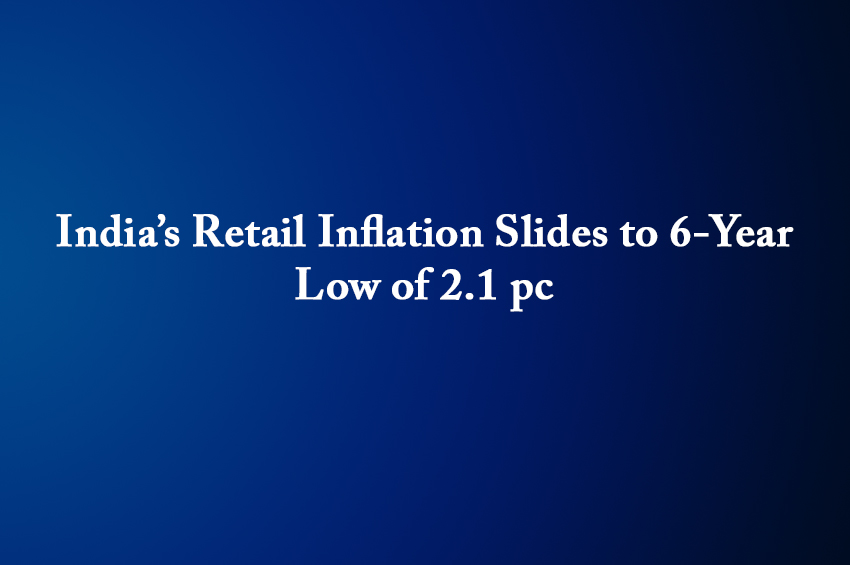Winning Bizness Economic Desk
The country’s retail inflation slid sharply to a six-year low of 2.10 per cent last month (June 2025). It reached close to the bottom-end of the Reserve Bank of India (RBI)’s target band of two per cent.
This lowest level of retail inflation in over six-years is primarily because of the southward movement in food prices.
Following the cooling down of food prices and consequently of retail inflation, India’s central bank, the Reserve Bank of India, now has a greater headroom to support growth through monetary easing.
The retail inflation number in May stood at 2.82 per cent.
Food prices which make up nearly half of the country’s consumer price index (CPI) basket registered a Year-on-Year (YoY) decline of 1.06 per cent in June.
An important highlight here is that vegetable prices slid sharply southward 19 per cent YoY in June, extending May’s 13.7 per cent decline.
The latest inflation data is significant because it underscores the impact of favourable monsoon rains which have bolstered crop production and helped ease food prices.
With inflation presently at the bottom-end of the Reserve Bank’s target range of 2-to-6 per cent, the country’s apex bank now has the headroom to continue trimming rates, if needed.
Here, a point to note is that the Reserve Bank cut its repo rate by 50 basis points (bps) or 0.50 per cent.
Another important point that requires highlighting is that the RBI also reduced its FY 26 retail inflation forecast to 3.7 per cent from four per cent, citing early arrival of monsoon rains and strong harvest expectations.
Core inflation, however, still remained on the higher side at between 4.4 per cent-to-4.5 per cent in June, up from the 4.17 per cent-to-4.20 per cent in the previous month of May.
June’s inflation number is very encouraging for India’s economy as it means that the RBI now has ample space to go in for rate cuts if it deems it necessary.
Horticulture Output Increases 3.7 pc in 2024-25 Season
The country’s production of horticulture crops is estimated to have increased by 3.66 per cent to 367.72-mt in the 2024-25 crop year (July-to-June).
The above figure is as per the second advanced estimates released by the Union Agriculture Ministry.
Output had slid southward to 354.74-mt in 2023-24 crop year from 355.54-mt in the previous year mainly due to a 20 per cent decline in onion production as compared to the previous year.
Horticultural crops’ production continues to be higher than foodgrains production in absolute terms though the growth rates in the last two-years were higher for the latter.
The output of rice, wheat, pulses and coarse cereals in the 2024-25 crop year was estimated at a record 353.2-mt, a six per cent climb as compared to the previous crop year.
The area under horticulture crops increased to 29.2-million hectares (Mha) in 2024-25 as against 29.08 Mha last year.
In the 2024-25 crop year, while output of fruits including mango and banana increased by 1.36 per cent to 114.5 MT, production of vegetables including onion, potato and tomato moved up by six per cent to 219.6 MT.
Potato and onion production in 2024-25 rose by 26 per cent and 5.46 per cent, respectively, to 60.17 MT and 57.05 MT.
The horticulture sector contributes about 33 per cent to the agriculture gross value added (GVA), making a significant contribution to the economy.
India’s iPhone Exports Zoom 53 pc in H1 2025
Apple’s contract manufacturers in the country continue to increase production and exports of iPhones despite tariff uncertainties, with India exporting in excess of 23.9-million iPhones in the first-half of this year (H1 2025).
This is a significantly high 53 per cent rise as compared to the same half year in 2024, a leading business publication quoting data from global research firm Canalys said.
Almost 78 per cent of iPhone exports from the country in H1 2025—nearly 18.6-million units—were to the United States (US).
A point to highlight here is that in June 2025 alone, 88 per cent of India’s iPhone exports were to the US as compared to 46 per cent in June 2024.
According to Canalys, the Netherlands, Czech Republic, the United Kingdom (UK) and Italy are the other markets to which India exports iPhones.
Adani Group Plans Hospitals in Mumbai, Ahmedabad
The Adani Group will foray into the healthcare space with plans to establish 1,000 bed hospitals in Mumbai and Ahmedabad.
This move into healthcare will be financed through the Adani family’s earlier commitment of Rs 60,000-crore dedicated to healthcare, education and skill development.
According to Mr Gautam Adani, the foray will involve the establishment of 1,000 bed integrated hospitals beginning with Mumbai and Ahmedabad.
The billionaire industrialist was addressing the annual conference of the Society for Minimally Invasive Spine Surgery—Asia Pacific, in Mumbai.
“We are investing in modular, scalable infrastructure of the kind that can expand rapidly in the face of pandemics or emergencies. We are championing the creation of large, world-class healthcare institutes that bring together innovation, patient care and applied learning under one roof,” Mr Adani said.
The campuses, designed in partnership with the Mayo Clinic, will merge clinical care, academic training and research into one eco-system. They aim to set global benchmarks in affordability, innovation and scale, Mr Adani added.
“Human-centric insurance products that support and empower families will be a cornerstone of the new healthcare architecture we will do our best to build,” the Adani group chief said.
He urged medical professionals to join this transformation by either building AI-based spinal diagnostics, mobile rural operating theatres or next-gen surgical centres.
Gems, Jewellery Exports Register 14 pc Decline in June
India’s gems and jewellery exports slid southward 14 per cent Year-on-Year (YoY) in June 2025. The total exports stood at USD 1,626.96-million (Rs 13,978.98-crore), down from the USD 1,897.25-million (Rs 15,836.94-crore) last year,
The above is as per the data from the Gems and Jewellery Export Promotion Council (GJEPC).
Imports slipped 2.96 per cent to USD 1,549.17-million (Rs 13,308.49-crore). Buying was adversely affected by high gold prices, a weak global demand and a dull domestic market.
Export of cut and polished diamonds slid sharply by 23.49 per cent to USD 778.78-million (Rs 6,692.94-crore) while imports of these diamonds slipped 7.03 per cent to USD 71.82-million (Rs 616.72-crore).
Rough diamond imports slipped 5.13 per cent to USD 3,222.93-million (Rs 27,567.68-crore). Lab-grown polished diamond exports fell 24.95 per cent to USD 66.67-milllion (Rs 572.86-crore).
An important point to note here is that China increased lab-grown production and tight price competition hurt the country’s shipments.
Gold jewellery exports, however, bucked the trend. They moved northward 5.75 per cent to USD 630.33-million (Rs 5,415.71-crore).
A higher demand from the Middle-East, the US and south-east Asia supported growth. What needs highlighting here is that many buyers turned to gold as a safe haven during global economic uncertainty.
Platinum jewellery exports expanded in double-digits at 13.56 per cent to USD 45.67-million (Rs 390.75-crore).
Rising interest among younger buyers and men, especially in the US, Japan and China boosted shipments.
Coloured gemstone exports rose 6.06 per cent to USD 96.7-million (Rs 826.44-crore). Bridal and designer jewellery trends and celebrity endorsements pushed-up demand.


